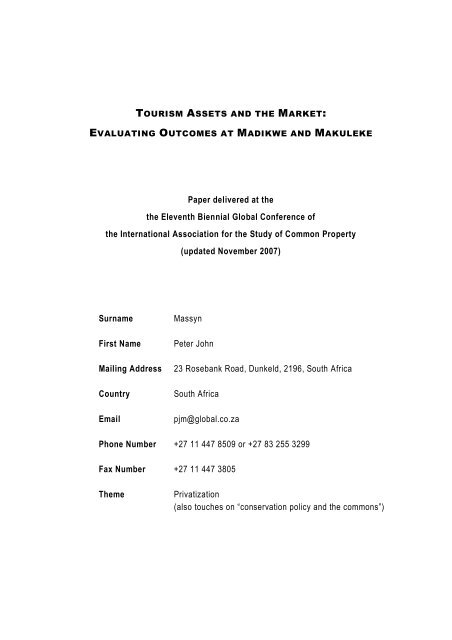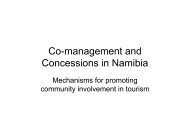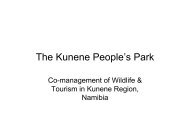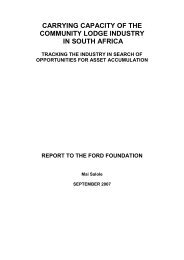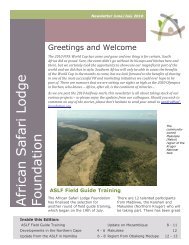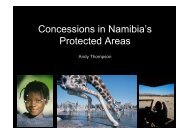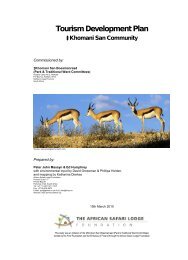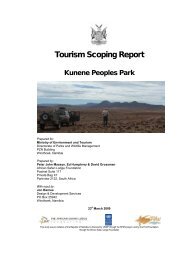Evaluating outcomes at Madikwe and Makuleke by Peter John Massyn
Evaluating outcomes at Madikwe and Makuleke by Peter John Massyn
Evaluating outcomes at Madikwe and Makuleke by Peter John Massyn
Create successful ePaper yourself
Turn your PDF publications into a flip-book with our unique Google optimized e-Paper software.
TOURISM ASSETS AND THE MARKET:EVALUATING OUTCOMES AT MADIKWE AND MAKULEKEPaper delivered <strong>at</strong> thethe Eleventh Biennial Global Conference ofthe Intern<strong>at</strong>ional Associ<strong>at</strong>ion for the Study of Common Property(upd<strong>at</strong>ed November 2007)SurnameFirst NameMailing AddressCountryEmail<strong>Massyn</strong><strong>Peter</strong> <strong>John</strong>23 Rosebank Road, Dunkeld, 2196, South AfricaSouth Africapjm@global.co.zaPhone Number +27 11 447 8509 or +27 83 255 3299Fax Number +27 11 447 3805ThemePriv<strong>at</strong>iz<strong>at</strong>ion(also touches on “conserv<strong>at</strong>ion policy <strong>and</strong> the commons”)
TABLE OF CONTENTS1. Introduction ............................................................................................................... 42. The <strong>Madikwe</strong> Experience........................................................................................... 62.1 Background .................................................................................................................. 62.2 Objective ...................................................................................................................... 82.3 Structural <strong>and</strong> legal arrangements................................................................................ 82.4 Capital funding ........................................................................................................... 102.5 Financial arrangements .............................................................................................. 112.6 Economic returns ....................................................................................................... 122.7 The community-level process ..................................................................................... 152.8 Conclusion ................................................................................................................. 173. The <strong>Makuleke</strong> Experience ....................................................................................... 193.1 Background ................................................................................................................ 193.2 Lodge development .................................................................................................... 203.3 Structural <strong>and</strong> legal arrangements.............................................................................. 213.4 Capital funding ........................................................................................................... 233.5 Financial arrangements .............................................................................................. 233.6 Economic returns ....................................................................................................... 233.7 Other developments ................................................................................................... 243.8 The community-level process ..................................................................................... 253.9 Conclusion ................................................................................................................. 274. Concluding thoughts................................................................................................ 285. Works Cited............................................................................................................. 29/2
ABSTRACTTourism enterprises based on n<strong>at</strong>ural <strong>at</strong>tractions are today regarded as important driversof development, particularly in remote areas with rich resource endowments but few otherformal economic opportunities. In these settings, however, the local poor typically provideonly unskilled labour with external interests supplying other factor inputs in the form ofl<strong>and</strong>, capital <strong>and</strong> skilled labour as well as other goods <strong>and</strong> services. This results in askewed distribution of returns th<strong>at</strong> does little to advance local economic development.Several interventions have <strong>at</strong>tempted to improve the integr<strong>at</strong>ion of the poor into thetourism market. One widely advoc<strong>at</strong>ed option is for the poor to make l<strong>and</strong> available fortourism development. The ability of the poor to trade in l<strong>and</strong> has however been widelyconstrained <strong>by</strong> a variety of factors, including insecure tenure <strong>and</strong> the lack of institutionalcapacity. This has often led to suboptimal <strong>outcomes</strong> in which communal resources areeffectively priv<strong>at</strong>ised with little common gain. Part of the solution to this problem is loc<strong>at</strong>edin tenure reform th<strong>at</strong> devolves resource rights to those denied them under colonialism.This has, in some cases, led to promising results, with rural residents acquiring tradablerights over one of the principal factors (l<strong>and</strong>) of the ecotourism market.These programmes have however rarely targeted Africa’s core protected areas, moreoften focusing on adjacent l<strong>and</strong>s where the rural poor are resident. Typically, ownership ofpublic conserv<strong>at</strong>ion assets remains vested in the st<strong>at</strong>e <strong>and</strong> commercial development isoutsourced to the priv<strong>at</strong>e sector. However, in a few recent cases, poor rural communitieshave acquired formal l<strong>and</strong> rights in core protected areas <strong>and</strong> used these rights to achievehigh levels of particip<strong>at</strong>ion in the tourism industry.The paper considers two such examples from the north of South Africa. In the first case,the Balete <strong>and</strong> B<strong>at</strong>lokwa communities obtained lease rights to a prime tourismconcessions in the <strong>Madikwe</strong> Game Reserve. In the second, the <strong>Makuleke</strong> communityacquired ownership of a portion of the Kruger N<strong>at</strong>ional Park through post-apartheid l<strong>and</strong>restitution. The paper critically examines the terms on which these communities integr<strong>at</strong>edtheir newly acquired assets into the market. In both instances, a clear rights framework,strong commercial orient<strong>at</strong>ion, competent technical advice <strong>and</strong> responsiveness to localinstitutional conditions contributed to strong <strong>outcomes</strong>. And, in both cases, broaderstructural reform cre<strong>at</strong>ed conditions seemingly conducive to an applic<strong>at</strong>ion of theapproach <strong>at</strong> scale.The paper notes these successes but also questions whether the <strong>outcomes</strong> have beenoptimal from a community perspective. There are indic<strong>at</strong>ions th<strong>at</strong>, while the communitieshave benefited considerably from their ownership of valuable resource rights, especiallythe <strong>Makuleke</strong>s may not have optimised the integr<strong>at</strong>ion of their l<strong>and</strong> into the market.Much has been written about the two cases. The paper draws on this wide-rangingliter<strong>at</strong>ure but also on the author’s extensive personal experience as a facilit<strong>at</strong>or intim<strong>at</strong>elyinvolved in both cases over a period of more than a decade.
1. INTRODUCTIONTourism enterprises based on Africa’s n<strong>at</strong>ural <strong>at</strong>tractions – including smallaccommod<strong>at</strong>ion establishments widely known as ‘safari lodges’ – are today generallyregarded as important drivers of development, particularly in remote areas with richresource endowments but few other formal economic opportunities 1 . There is a plethora ofd<strong>at</strong>a indic<strong>at</strong>ing th<strong>at</strong> the rural poor in these areas already benefit from the tourism market,mainly as sellers of labour to safari lodges. 2 But the involvement of the poor is curtailed <strong>by</strong>a number of factors. In rural African settings – often characterized <strong>by</strong> a shortage of skills,insecure l<strong>and</strong> rights <strong>and</strong> a high degree of informality – external interests typically capturea large proportion of the benefits gener<strong>at</strong>ed <strong>by</strong> the tourism market. The local poor oftenprovide only unskilled labour with outside suppliers meeting the industry’s otherrequirements. These include factor inputs in the form of l<strong>and</strong>, capital <strong>and</strong> skilled labour aswell as various intermedi<strong>at</strong>e goods <strong>and</strong> services. This results in a skewed distribution ofreturns th<strong>at</strong> does little to support social <strong>and</strong> economic advancement in the remote ruralareas where the tourism destin<strong>at</strong>ions are loc<strong>at</strong>ed. 3Simply promoting tourism growth in underdeveloped settings is clearly not a guarantee ofsustainable advances for the poor <strong>and</strong> disadvantaged of such regions. This poses animportant challenge to policy makers, local residents, the priv<strong>at</strong>e sector, donors <strong>and</strong>development practitioners: to devise str<strong>at</strong>egies th<strong>at</strong> simultaneously promote market-ledtourism growth <strong>and</strong> enhance the capacity of the local poor to benefit from th<strong>at</strong> growth.Recognising th<strong>at</strong> wages are a key source of revenue flow, several developmentinterventions have <strong>at</strong>tempted to improve the integr<strong>at</strong>ion of the poor <strong>by</strong> building the skillsthey are able to offer the industry, there<strong>by</strong> positioning them to capture a gre<strong>at</strong>erproportion of the more lucr<strong>at</strong>ive employment opportunities cre<strong>at</strong>ed <strong>by</strong> the tourism market.1 Certain comment<strong>at</strong>ors, while recognising the important potential of tourism in certain localities, havecautioned against excessive expect<strong>at</strong>ions pointing out th<strong>at</strong> tourism is not a development panacea: “Theextent to which the tourism industry can fulfil these expect<strong>at</strong>ions is questionable: in terms of its overallpotential for expansion, the distribution of th<strong>at</strong> potential <strong>and</strong> the pronounced constraints facing theindustry.” The ComMark Trust, 2005: 17.2 See, for example, <strong>Massyn</strong> <strong>and</strong> Koch, 2004; <strong>Massyn</strong> <strong>and</strong> Koch, 2005; <strong>and</strong> Poultney <strong>and</strong> Spenceley, 2004.3 “In the tourism sector, n<strong>at</strong>ional governments <strong>and</strong> donors have generally aimed to promote priv<strong>at</strong>e sectorinvestment, macro-economic growth <strong>and</strong> foreign exchange earnings, without specifically taking the needs<strong>and</strong> opportunities of the poor into account in tourism development. Donor-supported tourism master plansoften focus on cre<strong>at</strong>ing infrastructure, stimul<strong>at</strong>ing priv<strong>at</strong>e investment <strong>and</strong> <strong>at</strong>tracting intern<strong>at</strong>ional tourists.Investors are often intern<strong>at</strong>ional companies <strong>and</strong> local elites, whose profits are generally rep<strong>at</strong>ri<strong>at</strong>edabroad or to metropolitan centres. Links with the local economy are often weak, with the possibleexception of employment.” Ashley et al, 2000: 1-2./4
These programmes hold gre<strong>at</strong> promise for the advancement of the local poor up theemployment hierarchy as sellers of skilled labour <strong>and</strong> have, in some instances,substantially improved the particip<strong>at</strong>ion of the poor in the tourism market. 4Another option is for the poor to obtain formal l<strong>and</strong> rights <strong>and</strong> to make the l<strong>and</strong> thusacquired available to the tourism market. In Africa, the ability of the poor to trade in l<strong>and</strong>has however been widely constrained <strong>by</strong> the lack (or insecurity) of formal tenure rightsespecially in the communal sector. In general, tourism investors require secure rights tol<strong>and</strong> <strong>and</strong> associ<strong>at</strong>ed resources for periods th<strong>at</strong> enable reasonable returns on the capital<strong>and</strong> expertise invested in their businesses. Reputable investors tend either to avoid areaswith insecure tenure or, if they do invest, to select only those opportunities th<strong>at</strong> offer theprospect of a quick return on a limited investment. In such circumstances, development<strong>outcomes</strong> are characterised <strong>by</strong> the prolifer<strong>at</strong>ion of small, often precarious, oper<strong>at</strong>ors whoare generally unable to obtain rights within more formalised l<strong>and</strong> frameworks (such as onpriv<strong>at</strong>e l<strong>and</strong> or in public parks) because they are unable to compete against betterresourced rivals. They flourish in conditions of informality relying on personal rel<strong>at</strong>ionshipswith local – often tribal – elements <strong>and</strong> the lack of enforceability typical of the areas withinwhich they function. Their oper<strong>at</strong>ions are mostly small-scale, undercapitalised, vulnerable<strong>and</strong> of limited benefit to all but a h<strong>and</strong>ful of local employees. 5Part of the solution to this problem is loc<strong>at</strong>ed in tenure reform th<strong>at</strong> devolves resourcerights to those denied them under colonialism. Various African countries have, forexample, experimented with the transfer of rights to resources th<strong>at</strong> are valued <strong>by</strong>commercial users. These so-called ‘community based n<strong>at</strong>ural resource managementprogrammes' (CBNRM) have, in some cases, led to promising results, with rural residentsacquiring tradable rights over one of the principal factors (l<strong>and</strong>) of the n<strong>at</strong>ure-basedtourism market. These programmes have however rarely targeted Africa’s core protectedareas, more often focusing on adjacent l<strong>and</strong>s where the rural poor are resident. Typically,ownership of public conserv<strong>at</strong>ion assets remains vested in the st<strong>at</strong>e <strong>and</strong> commercialdevelopment <strong>and</strong> management – primarily lodge tourism – are outsourced to the priv<strong>at</strong>esector. 64 Wages are a key source of revenue flows from formal tourism enterprises, especially safari lodges, tolocal people. In most cases, the wage bill gener<strong>at</strong>es <strong>by</strong> far the biggest single flow of benefits to ruralhouseholds. In addition, these enterprises provide employment opportunities for women <strong>and</strong> othervulnerable groups in rural society. This allows poor households to receive direct payments from the firmswhereas lease fees or rentals are often intercepted <strong>by</strong> local elites or government structures before theyreach the household. <strong>Massyn</strong> & Koch, 2003: 26 – 28.5 This is a classic instance of a weak <strong>and</strong> fragmented property rights system cre<strong>at</strong>ing conditions underwhich priv<strong>at</strong>e sector activity is “informal, fragmented <strong>and</strong> local” (Prahalad, 2005: 79).6 Under this arrangement, which has become widespread in a context of economic liberaliz<strong>at</strong>ion, rentalsgener<strong>at</strong>ed <strong>by</strong> commercial enterprise in st<strong>at</strong>e-owned protected areas are used <strong>by</strong> the st<strong>at</strong>e in an effort to/5
However, in a few recent cases, poor rural communities have acquired formal l<strong>and</strong> rightsin core protected areas <strong>and</strong> used these rights to achieve high levels of particip<strong>at</strong>ion in thetourism industry. This paper considers two such examples from the north of South Africa.In the first case, the Balete <strong>and</strong> B<strong>at</strong>lokwa community obtained lease rights to a primetourism concessions in the <strong>Madikwe</strong> Game Reserve. In the second, the <strong>Makuleke</strong>community acquired ownership of a portion of the Kruger N<strong>at</strong>ional Park through postapartheidl<strong>and</strong> restitution. The paper critically examines the terms on which thesecommunities integr<strong>at</strong>ed their newly acquired assets into the market. In both instances, aclear rights framework, strong commercial orient<strong>at</strong>ion, competent technical advice <strong>and</strong>responsiveness to local institutional conditions contributed to strong <strong>outcomes</strong>. And, inboth cases, broader structural reform <strong>at</strong> the n<strong>at</strong>ional level cre<strong>at</strong>ed conditions seeminglyconducive to an applic<strong>at</strong>ion of the approach <strong>at</strong> scale.The paper notes these successes but also questions whether the <strong>outcomes</strong> have beenoptimal from a local perspective. There are indic<strong>at</strong>ions th<strong>at</strong>, while the communities havebenefited considerably from their ownership of valuable resource rights, especially the<strong>Makuleke</strong>s may not have optimised the integr<strong>at</strong>ion of their l<strong>and</strong> into the market.Much has been written about the two cases. The paper draws on this wide-rangingliter<strong>at</strong>ure but also on the author’s extensive personal experience as a facilit<strong>at</strong>or intim<strong>at</strong>elyinvolved in both cases over a period of more than a decade.2. THE MADIKWE EXPERIENCE 72.1 BackgroundDuring the l<strong>at</strong>e 1980s, the former South African government expropri<strong>at</strong>ed farml<strong>and</strong>sbelonging to white commercial interests along the Botswana border for incorpor<strong>at</strong>ion intothe then “independent” Bophut<strong>at</strong>swana. Based on a compar<strong>at</strong>ive l<strong>and</strong> use study th<strong>at</strong>argued the rel<strong>at</strong>ive merits of market-based wildlife tourism as the most efficient economicuse of the l<strong>and</strong>, the bantustan government opted to establish a major new game reserveoptimize cost recovery. The new approach to public conserv<strong>at</strong>ion thus sees the st<strong>at</strong>e seeking to offset thecosts of protected area management through the optimal harvesting of returns from commercialdevelopment on the l<strong>and</strong>. A critical consequence of the approach is reluctance <strong>by</strong> the st<strong>at</strong>e to cederesource rights – <strong>and</strong> rentals – in core protected areas to local rural residents. On the contrary, the st<strong>at</strong>eoften insists th<strong>at</strong> local interests compete in an open market for access to commercial opportunities <strong>and</strong>pay competitive rents for the use of the l<strong>and</strong>.7 The author was involved in the <strong>Madikwe</strong> Initi<strong>at</strong>ive as a director of the initi<strong>at</strong>ive’s implementing agency.The case study draws on personal experience <strong>and</strong> various rel<strong>at</strong>ed public<strong>at</strong>ions./6
on the expropri<strong>at</strong>ed l<strong>and</strong> <strong>and</strong> began implement<strong>at</strong>ion of wh<strong>at</strong> was <strong>at</strong> the time the largestreintroduction of wild animals ever undertaken. In its very genesis, <strong>Madikwe</strong> wastherefore viewed as an economic asset r<strong>at</strong>her than a biodiversity preserve; its primaryobjective – unlike most other n<strong>at</strong>ure reserves – was not biodiversity conserv<strong>at</strong>ion but theefficient gener<strong>at</strong>ion of economic benefit under a market-based approach th<strong>at</strong> relies heavilyon priv<strong>at</strong>e sector investment <strong>and</strong> expertise.cial : 8Structural arrangements <strong>at</strong> <strong>Madikwe</strong>Wildlife Est<strong>at</strong>eCommercial InfrastructureOwnership St<strong>at</strong>e St<strong>at</strong>e *Development St<strong>at</strong>e Priv<strong>at</strong>eManagement St<strong>at</strong>e Priv<strong>at</strong>e* The priv<strong>at</strong>e concessions are on a BOT (build, oper<strong>at</strong>e & transfer back) basis. Technically, the commercialinfrastructure – although funded, developed <strong>and</strong> oper<strong>at</strong>ed <strong>by</strong> the priv<strong>at</strong>e sector during the period of the lease –vests in the st<strong>at</strong>e as the owner of the l<strong>and</strong>.In line with the reserve’s emphasis on economic benefit, a programme designed to buildthe capacity of the <strong>Madikwe</strong> communities to benefit from the development of the reservewas launched in 1998. Known as the <strong>Madikwe</strong> Initi<strong>at</strong>ive, it was funded <strong>by</strong> a range of local<strong>and</strong> intern<strong>at</strong>ional donors <strong>and</strong> reported to a committee of key stakeholders includingelected represent<strong>at</strong>ives of the reserve’s neighbouring communities. The purpose of theiniti<strong>at</strong>ive was to “strengthen local communities so th<strong>at</strong> they [could] maximise returns from<strong>Madikwe</strong>.” 9At the outset of the <strong>Madikwe</strong> Initi<strong>at</strong>ive, there were essentially two sets of propertyinterests in <strong>Madikwe</strong>: the l<strong>and</strong> <strong>and</strong> its service infrastructure were st<strong>at</strong>e-owned <strong>and</strong>managed but the commercial lodges were developed <strong>and</strong> managed <strong>by</strong> the priv<strong>at</strong>e sector interms of negoti<strong>at</strong>ed leases involving build-oper<strong>at</strong>e-<strong>and</strong>-transfer-back (to the st<strong>at</strong>e)arrangements. Unlike some cases in South Africa – such as the Richtersveld, the<strong>Makuleke</strong> Region of the Kruger N<strong>at</strong>ional Park <strong>and</strong> the Kgalagadi N<strong>at</strong>ional Park where localpeople collectively hold title to parts of the protected areas – residents of the neighbouringsettlements did not hold any formal l<strong>and</strong> or resource rights in <strong>Madikwe</strong>. 10 One of the keyinnov<strong>at</strong>ions of the NWPTB – negoti<strong>at</strong>ed within the framework of the <strong>Madikwe</strong> Initi<strong>at</strong>ive –was an agreement to grant local residents commercial rights in the protected area. Thiseffectively cre<strong>at</strong>ed a third property interest in the game reserve – neighbouring8 See Relly, 2004, for a discussion of the economic impacts of <strong>Madikwe</strong>.9 <strong>Massyn</strong> & Koch, 2003: 21-31.10 <strong>Massyn</strong> & Koch, 2003: 23./7
‘communities’ structured as legally constituted collectives obtained long-term lease rightson terms substantially similar to those available to priv<strong>at</strong>e firms. This allowedneighbouring residents to particip<strong>at</strong>e in the mainstream of the n<strong>at</strong>ure-tourism led economyas if they were priv<strong>at</strong>e investors.The first such development, Buffalo Ridge Safari Lodge, opened its doors to trade inDecember 2004. It is owned <strong>by</strong> the Balete community who live in a village calledLekgophung just west of <strong>Madikwe</strong>. A second lodge, trading as Thakadu River Camp <strong>and</strong>owned <strong>by</strong> the B<strong>at</strong>lokwa community of Mol<strong>at</strong>edi, became oper<strong>at</strong>ional in August 2006. TheNWPTB has offered similar leases to two other neighbouring communities but theseprojects have stalled due to intra-communal conflicts.2.2 ObjectiveAccording to the Buffalo Ridge <strong>and</strong> Thakadu business plans, the core aim of the lodgeprojects was “to optimise the flow of benefits to the community without compromising thecommercial viability <strong>and</strong> long-term sustainability of the lodge as a high value tourismenterprise.” 11 The projects were thus conceptualised from the start as an experiment inwhich the southern African region’s current stress on wildlife tourism as a str<strong>at</strong>egicindustry is fused into a community-owned enterprise th<strong>at</strong> maximizes jobs, wages, leasefees <strong>and</strong> other forms of tangible benefit to rural people. Importantly, the approach wasrooted in a market-friendly orient<strong>at</strong>ion, focusing on improving the particip<strong>at</strong>ion of a groupof rural poor in the high value tourism market.2.3 Structural <strong>and</strong> legal arrangementsThe structural arrangements underpinning the projects are illustr<strong>at</strong>ed in the followingdiagram:11 Balete Ba Lekgophung Development Trust, 2003: 1./8
NWP&TBL<strong>and</strong>lord45-yearleaseFair rentalCommunity Trust(Balete/Sebolao)Develops facilityManages oper <strong>at</strong>ing10-year concession Oper<strong>at</strong>ing feesubleaseOper<strong>at</strong>ing CompanyPriv<strong>at</strong>e sect or oper<strong>at</strong>orMOT appointmentLegal vehicles representing the communities of Lekgophung (the Balete) <strong>and</strong> Mol<strong>at</strong>edi(the B<strong>at</strong>lokwa) were established <strong>at</strong> the outset of the project. The Balete Ba LekgophungDevelopment Trust then entered into a 45-year lease agreements with the NWPTB for thedevelopment, maintenance <strong>and</strong> oper<strong>at</strong>ion of a 16-bed lodge <strong>at</strong> a prime site in the west of<strong>Madikwe</strong>. The Sebolao Development Trust (representing the B<strong>at</strong>lokwa) entered into asimilar agreement for a 24-bed lodge <strong>at</strong> a site in the southeast of the park. In addition,the trusts acquired traversing rights over the entire game reserve. At the end of the leaseperiod, the trusts are obliged to transfer back the lodges to the NWPTB “free of charges,liens, claims or encumbrances of any kind wh<strong>at</strong>soever, free of any liabilities, <strong>and</strong> in goodcondition”. 12 The deeds of lease are closely modelled on the st<strong>and</strong>ard agreement used <strong>by</strong>the NWPTB in its dealings with the priv<strong>at</strong>e sector. The trusts thus obtained sets of rights<strong>and</strong> oblig<strong>at</strong>ions similar to those acquired <strong>by</strong> priv<strong>at</strong>e enterprises under the public-priv<strong>at</strong>epartnership rules governing st<strong>at</strong>e-owned assets such as <strong>Madikwe</strong>. In effect, thecommunities, represented <strong>by</strong> properly constituted legal structures, stepped into theposition of the priv<strong>at</strong>e sector for the purposes of implementing the projects.In terms of the lease agreements, the trusts are responsible for the development,maintenance <strong>and</strong> oper<strong>at</strong>ion of the lodges. After careful deliber<strong>at</strong>ion based on technicaladvice provided under the <strong>Madikwe</strong> Initi<strong>at</strong>ive, the trusts decided to retain responsibility forthe funding <strong>and</strong> development of the fixed infrastructure but set themselves the task ofraising the capital required to develop the lodges (see below). But from the outset thetrusts recognised th<strong>at</strong> they did not have the specialised capacity required to manage <strong>and</strong>oper<strong>at</strong>e the lodges once they were developed. They therefore decided to contract in asuitably qualified priv<strong>at</strong>e partner to maintain <strong>and</strong> oper<strong>at</strong>e the lodge for an initial ten-yearperiod. In order to identify a suitable partner, the trusts called for proposals <strong>and</strong> selected12 North West Parks <strong>and</strong> Tourism Board & the Balete Ba Lekgophung Development Trust, 2004: 14./9
an established priv<strong>at</strong>e sector company with a proven record of accomplishment in themarketing <strong>and</strong> oper<strong>at</strong>ion of tourist lodges. Interestingly, the two trusts selected the samecompany, which thus gained an important economy of scale <strong>and</strong> br<strong>and</strong>ing opportunity in<strong>Madikwe</strong>.During the early stages of the projects, the oper<strong>at</strong>ing company was expected to establishthe lodges as br<strong>and</strong>s in the market <strong>and</strong> achieve prescribed social goals, such as theemployment <strong>and</strong> training of local staff as well as the use of local entrepreneurs for theprocurement of a range of goods <strong>and</strong> services. These goals are contractually entrenchedin the oper<strong>at</strong>ing agreements between the trusts <strong>and</strong> the priv<strong>at</strong>e partner. They thereforeform part of a clear rights framework, which the trusts can enforce should the oper<strong>at</strong>or failto discharge its empowerment oblig<strong>at</strong>ions. 13Upon termin<strong>at</strong>ion of the contract, the oper<strong>at</strong>ing company must transfer back the facilitiesto the trusts, which will either reappoint the oper<strong>at</strong>ing company, or make altern<strong>at</strong>ivearrangements for the future management <strong>and</strong> marketing of the lodges.2.4 Capital fundingIn both cases, the NWPTB insisted on a competitive rental for the long-term lease rightsacquired <strong>by</strong> the trusts. With support from the <strong>Madikwe</strong> Initi<strong>at</strong>ive, the trusts used theserights as a bargaining pl<strong>at</strong>form from which to secure an advantageous set ofarrangements with a priv<strong>at</strong>e oper<strong>at</strong>ing partner. But it meant the trusts could not use l<strong>and</strong>rentals to gear the loans they required to develop the lodge. Under these circumstances,the trusts made applic<strong>at</strong>ion to the Community Equity Fund (CEF) of Khula EnterpriseFinance Limited, a parast<strong>at</strong>al grant-making facility designed to assist the historicallydisadvantaged poor with the capitaliz<strong>at</strong>ion of initial equity in high value agriculture <strong>and</strong>tourism ventures. These grants were disbursed in conjunction with deferred repaymentloans origin<strong>at</strong>ing in Khula’s L<strong>and</strong> Empowerment Credit Facility (LECF) but extended via13 The following extract from the oper<strong>at</strong>ing contract provides an example of the affirm<strong>at</strong>ive oblig<strong>at</strong>ionsimposed on the oper<strong>at</strong>or: “Where Members of the Balete Ba Lekgophung with the necessary skillsrequired <strong>by</strong> the Oper<strong>at</strong>or are not available, the Oper<strong>at</strong>or shall train Members of the Balete Ba Lekgophungto acquire, develop <strong>and</strong> build such skills. In this event, the Oper<strong>at</strong>or shall submit to the Tenant a trainingprogramme in writing, including a realistic timetable <strong>and</strong> quantified targets, designed to prepare Membersof the Balete Ba Lekgophung to acquire, develop <strong>and</strong> build the skills necessary to oper<strong>at</strong>e <strong>and</strong> maintainthe Lodge. Upon approval in writing <strong>by</strong> the Tenant, the Oper<strong>at</strong>or shall commence implement<strong>at</strong>ion of thetraining programme. The Oper<strong>at</strong>or shall be responsible for the cost of the training programme, providedth<strong>at</strong> the Oper<strong>at</strong>or shall have the right to raise funds for this purpose from third parties. Any failure toimplement the training programme according to the timetable <strong>and</strong> targets contained in the programmeshall be deemed a m<strong>at</strong>erial breach of this Contract.” Balete Ba Lekgophung Development Trust & TheN<strong>at</strong>ure Workshop (Pty) Ltd, 2004: 8./10
isk-bearing commercial intermediaries. The LECF was thus a wholesaling facility th<strong>at</strong>extends loans via credit-r<strong>at</strong>ed banks th<strong>at</strong> were expected to carry the risk associ<strong>at</strong>ed withthe loans. In effect, the combin<strong>at</strong>ion of the CEF <strong>and</strong> LECF assisted the poor with theinitial capitalis<strong>at</strong>ion of equity which then allowed them to raise a risk-bearing loan viaordinary financial institutions.In the case of Lekgophung <strong>and</strong> Mol<strong>at</strong>edi, South Africa’s Industrial DevelopmentCorpor<strong>at</strong>ion (IDC) acted as the intermediary for the Khula transactions. The IDC screened<strong>and</strong> approved applic<strong>at</strong>iosn from the trusts, which involved grants of approxim<strong>at</strong>ely R4million <strong>and</strong> loans of R4.5 million respectively 14 . The rights of the trusts in terms of thelease <strong>and</strong> oper<strong>at</strong>ing agreements were ceded to the IDC in security for the debt.Importantly, the arrangement involves a risk-bearing outside financier (in the form of theIDC) th<strong>at</strong> s<strong>at</strong>isfied itself of the probable commercial viability of the enterprises. In bothcases, however, the IDC required shareholders’ contributions of <strong>at</strong> least 50% of the totalcapital expenditure on fixed improvements. The CEF grants were insufficient to fully coverthis requirement <strong>and</strong> both trusts received recoverable grants from the Ford Found<strong>at</strong>ion toboost their equity contributions to the projects.Under its agreement with the trusts, the oper<strong>at</strong>ing company funded the fittings,furnishings, equipment, pre-opening expenses <strong>and</strong> oper<strong>at</strong>ing capital required <strong>by</strong> theenterprises. The oper<strong>at</strong>or therefore did not simply acquire management contracts overalready fitted <strong>and</strong> furnished facilities. Instead, it acquired oper<strong>at</strong>ing subleases requiring asizeable own investment – estim<strong>at</strong>ed <strong>at</strong> approxim<strong>at</strong>ely R4-million per lodge – th<strong>at</strong> exposedit to significant financial risk. This was seen as a crucial further mechanism to safeguardthe market-based integrity of the projects: the willingness of the priv<strong>at</strong>e oper<strong>at</strong>or, basedon its own assessment, to bear substantial risk in the venture was taken as an indic<strong>at</strong>ionof a serious commitment to the business <strong>by</strong> a seasoned tourism entrepreneur.2.5 Financial arrangementsIn terms of the lease agreements, the trusts pays competitive rentals to the NWPTBcomprising:! a fixed fee of R40,00 per year (escal<strong>at</strong>ing <strong>at</strong> an infl<strong>at</strong>ionary index); <strong>and</strong>! 6% of the annual gross revenue gener<strong>at</strong>ed <strong>by</strong> the lodge.In terms of the oper<strong>at</strong>ing agreements, the oper<strong>at</strong>ing partner:! pays the rental due to the NWPTB, <strong>and</strong>14 The South African R<strong>and</strong> has maintained a value of approxim<strong>at</strong>ely R6 to the US$ for the last two years./11
! posts a performance bond required in terms of the lease agreement between thetrust <strong>and</strong> NWPTB.In addition, the oper<strong>at</strong>ing partner pays the trusts:! R5,000 per commercial bed (the fixed component) annually in advance (escal<strong>at</strong>ing <strong>at</strong>an infl<strong>at</strong>ionary index); <strong>and</strong>! 10% of the annual gross revenue gener<strong>at</strong>ed <strong>by</strong> the lodge (the variable component) inquarterly instalments paid within 30 days of the end of each quarter.Proponents of market liberalis<strong>at</strong>ion often caution against direct subsidies such as thoseused in the Balete <strong>and</strong> B<strong>at</strong>lokwa cases because they risk distorting the market <strong>by</strong>undermining incentives for priv<strong>at</strong>e sector actors (who do not receive such subsidies). It ishowever important to note th<strong>at</strong> the arrangements sketched above should not lead to pricedistortion because commercial r<strong>at</strong>es are paid for the major factor inputs (l<strong>and</strong> <strong>and</strong> capital).The l<strong>and</strong> rentals due to the NWPTB were benchmarked against typical rentals achieved inagreements with the priv<strong>at</strong>e sector <strong>and</strong> the fees payable <strong>by</strong> the oper<strong>at</strong>ing partner weredesigned to give the trusts a commercial return on the capital invested in the lodge overthe dur<strong>at</strong>ion of the agreements. The capital subsidies (in the form of a grant to the trusts)were used to fund the communities’ equity contribution (allowing them to leverageadditional loans) but the subsidies did not affect the price paid <strong>by</strong> the oper<strong>at</strong>or for use ofthe capital assets. The grants did not reduce the cost of capital to the priv<strong>at</strong>e partner:over the life of the oper<strong>at</strong>ing agreements, the oper<strong>at</strong>or pays a full commercial r<strong>at</strong>e for thecapital assets employed in the businesses. The priv<strong>at</strong>e firm’s cost structure – <strong>and</strong>therefore the pricing of its product in the market – is unaffected <strong>by</strong> the subsidy; theoper<strong>at</strong>or is therefore on equal terms with other priv<strong>at</strong>e firms th<strong>at</strong> have sourced theirinvestment in the commercial capital markets.2.6 Economic returnsDuring the construction phase of the Balete project, which was completed in November2005, residents of Lekgophung received approxim<strong>at</strong>ely R1.3 million in the form ofremuner<strong>at</strong>ion for labour <strong>and</strong> various small construction contracts. At m<strong>at</strong>urity, it isestim<strong>at</strong>ed th<strong>at</strong> the lodge will deliver more than R2.2-million per annum in sustainableincome to rural households in the acutely impoverished Lekgophung village. This will bemade up of employment benefits of approxim<strong>at</strong>ely R950,000; oper<strong>at</strong>ing fees ofapproxim<strong>at</strong>ely R1,000,000 <strong>and</strong> small business contracts of approxim<strong>at</strong>ely R250,000 peryear.Residents of Mol<strong>at</strong>edi received benefits of approxim<strong>at</strong>ely R1.55 million during theconstruction phase. Thakadu River Camp is estim<strong>at</strong>ed to deliver approxim<strong>at</strong>ely 25% more/12
enefit than Buffalo Ridge to its local owners over the lifespan of the project. This is duemainly due to the larger size of the lodge.These figures illustr<strong>at</strong>e th<strong>at</strong> this arrangement – where a community-owned entity holdsclearly defined commercial rights – has the potential to significantly improve returns to thelocal poor. In the Balete <strong>and</strong> B<strong>at</strong>lokwa cases, this impact is enhanced <strong>by</strong> the rel<strong>at</strong>ivelysmall size of the beneficiary groups. For example, during the time of the most recentsurvey, the village of Lekgophung had a total popul<strong>at</strong>ion of about 2,300 persons in justover 600 households. The total disposable income gener<strong>at</strong>ed in the village was estim<strong>at</strong>ed<strong>at</strong> less than R600,000 per month, with average household income around R900 permonth. This means th<strong>at</strong> the benefits captured from the single lodge enterprise will boostaverage household income in the village <strong>by</strong> about R3,600 per annum <strong>and</strong> overalldisposable income <strong>by</strong> more than 30%.The predicted performance of Buffalo Ridge, as well a recent survey of its actualperformance since becoming oper<strong>at</strong>ional, also show th<strong>at</strong> the community-owned lodgeoutperforms similar priv<strong>at</strong>e lodges in terms of returns to the local poor. Based on a surveyof several lodges in <strong>Madikwe</strong>, <strong>Massyn</strong> <strong>and</strong> Koch conclude: “The figures show th<strong>at</strong> the 16-bed Lekgophung Lodge gener<strong>at</strong>es a gre<strong>at</strong>er total flow of benefit than the 60-bed TauLodge. This reflects the importance of community-ownership of the commercialinfrastructure (which in the Lekgophung case has been converted into very significantgains for its rural beneficiaries).” 15 More recently, the oper<strong>at</strong>or reported tough tradingconditions, especially during the first half of 2006 when the lodge performed somewh<strong>at</strong>below the levels predicted in the original business plan. This led to some concern th<strong>at</strong> theBalete Trust might struggle to meet its debt servicing commitments in 2007/8. However,in August 2006, the oper<strong>at</strong>or – with the consent of the trust – amalgam<strong>at</strong>ed its businesswith The <strong>Madikwe</strong> Collection, a group with a significant economy of scale in <strong>Madikwe</strong>.The most recent figures from Buffalo Ridge indic<strong>at</strong>e th<strong>at</strong> the lodge’s performance hasimproved with record occupancies <strong>and</strong> revenues in the course of 2007.Thakadu River Camp was launched under the new oper<strong>at</strong>ing arrangement describedabove. The lodge has done extremely well during its opening months, performing abovepredicted levels <strong>and</strong> gener<strong>at</strong>ing a profit during its first six months of oper<strong>at</strong>ion. The lodgeis also the first in <strong>Madikwe</strong> to be fully staffed from the local community with all positions –including top management – filled <strong>by</strong> residents of Mol<strong>at</strong>edi. Early indic<strong>at</strong>ions are thereforeth<strong>at</strong> Thakadu will exceed the local benefit levels anticip<strong>at</strong>ed in the planning stages of theproject.15 <strong>Massyn</strong> & Koch, 2004: 78./13
A word of caution is perhaps appropri<strong>at</strong>e here. It is often argued th<strong>at</strong> the sectoral<strong>at</strong>tributes of the tourism industry cre<strong>at</strong>e significant risks for the sustainability – or indeedthe achievability – of high levels of community benefit. Tourism generally, <strong>and</strong> n<strong>at</strong>uretourism specifically, is a large <strong>and</strong> highly competitive global industry with complexlinkages <strong>at</strong> the local, n<strong>at</strong>ional, regional <strong>and</strong> intern<strong>at</strong>ional scales where supply <strong>and</strong> dem<strong>and</strong>conditions are often shaped <strong>by</strong> external factors beyond the control of local actors. 16This is undoubtedly true, <strong>and</strong> there are many instances where the industry – <strong>and</strong> localbenefit with it – has suffered due to events beyond the tourism sites. The recent nearcollapse of tourism in Zimbabwe is a southern African case in point. Even in <strong>Madikwe</strong>, therobust commercialis<strong>at</strong>ion approach of the NWPTB has cre<strong>at</strong>ed a rapid expansion in supplyof beds th<strong>at</strong> has led to cut-thro<strong>at</strong> conditions with a large number of new entrantscompeting aggressively for market share. Under such circumstances, a lodge like BuffaloRidge faced severe competitive pressures <strong>and</strong> fell somewh<strong>at</strong> short in delivery of economicbenefits during its establishment phase. (These pressures are likely to be especially acutein the short term as <strong>Madikwe</strong> struggles to emerge as a regional destin<strong>at</strong>ion capable of<strong>at</strong>tracting sufficient market share.) But this is not in my view a reason to eschewparticip<strong>at</strong>ion in the tourism market. It is doubtful whether the risks flowing from thefluctu<strong>at</strong>ions <strong>and</strong> uncertainties of tourism are in fact gre<strong>at</strong>er than those associ<strong>at</strong>ed withother global industries (such as mining or agriculture) or indeed subsistence str<strong>at</strong>egiesth<strong>at</strong> often make poor households heavily reliant on n<strong>at</strong>ure (which can fluctu<strong>at</strong>e <strong>at</strong> least asmuch as, <strong>and</strong> often with worse consequences than, the market).Wh<strong>at</strong>ever the case, it is clear th<strong>at</strong> the rural poor are inherently vulnerably. Tourism – likeother sectors on which the poor rely – faces real risks which should be factored into theoverall livelihood str<strong>at</strong>egy of poor rural communities as they integr<strong>at</strong>e into this particularmarket. Having recognised the risks, it is however also clear th<strong>at</strong> particip<strong>at</strong>ion in thetourism industry holds gre<strong>at</strong> potential for the economic advancement of the poor providedthe industry’s specific risk profile is understood <strong>and</strong> appropri<strong>at</strong>e mitig<strong>at</strong>ory measures areput in place. This is a complex argument which is beyond the scope of the current paper.Suffice it to say th<strong>at</strong> the arrangements <strong>at</strong> Buffalo Ridge <strong>and</strong> Thakadu were designed withthis in mind: the very decision to contract the services of a well-endowed <strong>and</strong> provenpartner was rooted in an underst<strong>and</strong>ing th<strong>at</strong> the competitive conditions of the high valuetourism market require oper<strong>at</strong>ing <strong>and</strong> marketing resources far beyond the capabilities of agroup of rural residents. Given this partnership, the community-owned lodges in Madikewappear to be rel<strong>at</strong>ively well positioned to we<strong>at</strong>her the storms of competition <strong>and</strong> to deliverthe economic benefits sketched above, especially under the new arrangements sketchedabove.16 See, for example, Turner, 2004: 6 – 9./14
2.7 The community-level processFrom the outset, the <strong>Madikwe</strong> Initi<strong>at</strong>ive recognised th<strong>at</strong> the notion of ‘community’ was infact inappropri<strong>at</strong>e when describing the various dispar<strong>at</strong>e groupings th<strong>at</strong> existed in <strong>and</strong>between the villages. <strong>Massyn</strong> <strong>and</strong> Koch describe the “fragment<strong>at</strong>ion <strong>and</strong> fissure” th<strong>at</strong>characterised the politics <strong>and</strong> institutional conditions <strong>at</strong> the local level: “complex <strong>and</strong>unstable local governance was one of the key problems encountered in the early stages oftrying to cre<strong>at</strong>e some real integr<strong>at</strong>ion between the game reserve <strong>and</strong> the socio-economicneeds of the village residents.” 17In <strong>at</strong>tempting to establish coherent institutions to take ownership of the opportunitiesoffered <strong>by</strong> the NWPTB the <strong>Madikwe</strong> Initi<strong>at</strong>ive thus faced a major challenge familiar tomany working in the development field. 18 The establishment of development trusts <strong>at</strong>Lekgophung <strong>and</strong> Mol<strong>at</strong>edi required an intensive institution-building programme funded <strong>and</strong>coordin<strong>at</strong>ed <strong>by</strong> the <strong>Madikwe</strong> Initi<strong>at</strong>ive. Given the social complexity described above, thisprocess had to be highly responsive to local conditions <strong>and</strong> closely integr<strong>at</strong>ed with villagelevelpower structures <strong>and</strong> local government activities. It included extensive discussion oflegal options <strong>and</strong> their implic<strong>at</strong>ions in community workshops, training for trustees, <strong>and</strong>support in establishing the trusts. “Key support providers during the MI have includedMafisa, the Centre for Community Law <strong>and</strong> Development, the Community DevelopmentOfficer of the Local Government, <strong>and</strong> more recently the NWPTB Community DevelopmentOfficer. General practice under the <strong>Madikwe</strong> Initi<strong>at</strong>ive of the principles of particip<strong>at</strong>ion,consult<strong>at</strong>ion <strong>and</strong> transparency has strengthened the culture of democracy <strong>and</strong>accountability.” 19The key intervention of the <strong>Madikwe</strong> Initi<strong>at</strong>ive “was to recognize th<strong>at</strong> the residents of thedifferent villages around <strong>Madikwe</strong> did not form a single cohesive ‘community’ <strong>and</strong> th<strong>at</strong>there were, indeed, many different groups <strong>and</strong> ‘stakeholders’ active in <strong>and</strong> around thereserve.” Instead of relying on some fictional notion of community coherence, theprogramme set about facilit<strong>at</strong>ing new institutional frameworks in the various villages th<strong>at</strong>recognised the social complexities <strong>at</strong> each loc<strong>at</strong>ion. A bottom-up planning process wasstarted “to cre<strong>at</strong>e legal entities th<strong>at</strong> would replace the multiple <strong>and</strong> fragmented structures… with stable <strong>and</strong> properly constituted structures capable of … managing the various17 <strong>Massyn</strong> & Koch, 2003: 24. Many other scholars have challenged the notion of ‘communities’ as coherent<strong>and</strong> homogenous collectives. See, for example, Turner, 2004 <strong>and</strong> Agrawal & Gibson, 1999: 629 – 649.18 The effective integr<strong>at</strong>ion of rural communities, characterised <strong>by</strong> underdeveloped human <strong>and</strong> socialcapital, “into a modern, sophistic<strong>at</strong>ed export service industry like tourism is an endeavour of Herculeanproportions.” See The ComMark Trust, 2005: 7.19 <strong>Massyn</strong> & Swan, 2003: 12 –13./15
commercial activities th<strong>at</strong> were being cre<strong>at</strong>ed in <strong>and</strong> around the reserve for localresidents.” This institution building process “was closely integr<strong>at</strong>ed with the activities oflocal government to ensure th<strong>at</strong> the represent<strong>at</strong>ive entities formed through the initi<strong>at</strong>iveknitted into the frameworks <strong>and</strong> priorities of the new municipalities. The outcome was theestablishment of [a] legally constituted development trust, which was broadly based… butalso closely aligned to both traditional tribal <strong>and</strong> local government-sponsored structures.Amongst many gains, this alignment allowed the trust to draw on the existingadministr<strong>at</strong>ive infrastructure of the village”. 20The ongoing governance performance of the Balete <strong>and</strong> Sebolao trusts will largely be afactor of local social capital. “In addition to the formal legal structure, local social <strong>and</strong>organis<strong>at</strong>ional culture, leadership <strong>and</strong> gender dynamics are key factors. The Balete ethnicgroup has been rel<strong>at</strong>ively successful in maintaining traditional cultural norms <strong>and</strong> values.In addition, democr<strong>at</strong>ic culture has evolved through the village development structures inrecent years, in particular in the local government-facilit<strong>at</strong>ed RDP Forum.” 21 In everydaypractice, these traditional norms <strong>and</strong> leadership dynamics will continue to exert influence.Already, it is evident th<strong>at</strong> conditions in the two villages differ considerably. InLekgophung, the tribal authority <strong>and</strong> village administr<strong>at</strong>ion are rel<strong>at</strong>ively weak <strong>and</strong>involved in complex disputes with a neighbouring chieftaincy th<strong>at</strong> collabor<strong>at</strong>ed closely withthe former Bantustan regime of Bophut<strong>at</strong>swana <strong>and</strong> th<strong>at</strong> claims paramountcy over theBalete. This has led to the system<strong>at</strong>ic underdevelopment of Lekgophung over manyyears, which is evident from a number of welfare indic<strong>at</strong>ors th<strong>at</strong> show the village to becompar<strong>at</strong>ively worse off than its immedi<strong>at</strong>e neighbours. One of the many consequences ofthis situ<strong>at</strong>ion is th<strong>at</strong> the Balete trust could not draw on a functioning local tribal or villageadministr<strong>at</strong>ion. It has instead had to develop its own capacity in difficult circumstances<strong>and</strong> with limited resources. The case <strong>at</strong> Mol<strong>at</strong>edi is very different where a strongtraditional authority – with well-established links to the new political structures <strong>at</strong> local <strong>and</strong>provincial level – has combined well with post-apartheid local government. The SebolaoTrust has drawn on the legitimacy <strong>and</strong> institutional capacity of these structures. It quicklyestablished a rel<strong>at</strong>ively efficient administr<strong>at</strong>ion th<strong>at</strong>, for example, adminstered the entireconstruction budget (R10-million) <strong>at</strong> Thakadu.The stability of the trusts <strong>and</strong> their ability to manage <strong>and</strong> disburse significant resourceswill be tested in the coming years. There are however certain factors th<strong>at</strong> count in theirfavour. First, the boards of trustees include outside appointments: a lawyer from theCentre for Community Law <strong>and</strong> Development, a regional NGO based in a provincialuniversity, <strong>and</strong> a represent<strong>at</strong>ive of local government. These persons bring specific skills20 <strong>Massyn</strong> & Koch, 2003: 25.21 <strong>Massyn</strong> & Swan, 2003: 13./16
<strong>and</strong> a high degree of commitment to the governing bodies of the trusts. Second, thepriv<strong>at</strong>e oper<strong>at</strong>ing partner provides ongoing support to the administr<strong>at</strong>ion of the trusts. Thissupport is rooted in the partnership between the two parties: the oper<strong>at</strong>or derives its rightsin the businesses from the trusts (which hold the head leases <strong>and</strong> “own” the lodges) <strong>and</strong>therefore has a clear – <strong>and</strong> continuing – interest in ensuring th<strong>at</strong> the trusts areadministered properly <strong>and</strong> comply with all their legal oblig<strong>at</strong>ions. In this sense, asupportive partnership, rooted in self-interest, has been established between a wellresourcedpriv<strong>at</strong>e business <strong>and</strong> the two local community trusts. Nevertheless, the trustsinvolve multiple <strong>and</strong> often conflicting local interests <strong>and</strong> it is certain th<strong>at</strong> their institutionalcoherence will be strained as they medi<strong>at</strong>e struggles around the distribution of resources<strong>and</strong> perceived disparities in benefit. This is likely to be particularly testing <strong>at</strong> Lekgophungwhere local socio-political conditions are less favourable <strong>and</strong> where the ability of thebusiness to service the debt incurred <strong>by</strong> the trust has been tested <strong>by</strong> the earlyunderperformance of the lodge. Whether the trusts maintain a sufficient degree oforganis<strong>at</strong>ional integrity will be one of the long term tests of success for the Balete <strong>and</strong>B<strong>at</strong>lokwa projects.2.8 ConclusionAs part of broader structural reform, many of southern Africa’s conserv<strong>at</strong>ion agencies arecurrently undertaking programmes to commercialise the wildlife est<strong>at</strong>e under their controlin a manner similar to the approach pioneered <strong>at</strong> <strong>Madikwe</strong>. Widespread market-led reformof the region’s st<strong>at</strong>e-owned conserv<strong>at</strong>ion est<strong>at</strong>e cre<strong>at</strong>es significant opportunities for anapplic<strong>at</strong>ion of the Balete/B<strong>at</strong>lokwa model <strong>at</strong> scale across southern Africa.Interestingly, the approach has been adopted <strong>by</strong> two of southern Africa’s premier gamelodge oper<strong>at</strong>ing companies. Wilderness Safaris is already involved in several suchpartnerships with local communities in South Africa <strong>and</strong> elsewhere on the subcontinent.And Conserv<strong>at</strong>ion Corpor<strong>at</strong>ion Africa is considering similar partnerships for newdevelopments <strong>at</strong> several of its existing lodge nodes. The adoption of the “<strong>Madikwe</strong> model”<strong>by</strong> major priv<strong>at</strong>e firms is one of the clearest indic<strong>at</strong>ions th<strong>at</strong> the <strong>Madikwe</strong> project has“opened a credible p<strong>at</strong>h to a more inclusive market without ongoing developmentalintervention or subsidy”. In this way, it would seem the project has passed the“developing the market” test prescribed <strong>by</strong> Gibson, et al. 2222 “While there are compar<strong>at</strong>ively few hard <strong>and</strong> fast ‘do-<strong>and</strong>-don’t’ rules in MMW4P, the same underlyingtest for actions always applies: is this action contributing to the development of the market? Or theconverse, is it distorting the market? Is this activity consistent with out vision of how this market can workmore effectively <strong>and</strong> sustainably for the poor in the future? Can we identify a credible p<strong>at</strong>h to afunctioning market without on-going development intervention or subsidy? Is this intervention addressing/17
The apparent success of the <strong>Madikwe</strong> model may be <strong>at</strong>tributed to several factorsincluding:Market-friendly approachThe <strong>Madikwe</strong> project was characterised <strong>by</strong> a thoroughgoing commitment to the principlesof market-based sustainability during all the stages of the project cycle (conceptualis<strong>at</strong>ion,planning <strong>and</strong> implement<strong>at</strong>ion). It appears the interventions of the support programme <strong>at</strong><strong>Madikwe</strong> were consistently designed to increase the poor’s level of particip<strong>at</strong>ion in anenterprise which was geared to oper<strong>at</strong>e sustainably within the highly competitive tourismmarket. So, for example, the project involves risk-bearing commercial partners, both asfinanciers <strong>and</strong> oper<strong>at</strong>ors of the capital assets. These partners are well suited to ensuremarket sustainability not least because they are exposed to significant financial risk.Particularly interesting was the use of a rel<strong>at</strong>ively small grant to fund the community’sequity in the capital assets, which was then used to leverage loans <strong>and</strong> investments froma variety of commercial sources in a manner th<strong>at</strong> avoids distortion of incentives or prices.Conducive institutional environmentThe institutional environment within which the <strong>Madikwe</strong> projects unfolded was largelyconducive to the establishment of a community-owned but market-based enterprise.! The public-priv<strong>at</strong>e partnership rules applying to commercial development of st<strong>at</strong>eownedparks provided a stable set of rules within which the roles, rights <strong>and</strong>responsibilities of the various parties could be clearly defined. The communitypartners acquired formal l<strong>and</strong> rights from the st<strong>at</strong>e within a settled legal framework<strong>and</strong> were able to use these rights to structure an advantageous rel<strong>at</strong>ionship with apriv<strong>at</strong>e oper<strong>at</strong>ing partner. Importantly, the arrangement s<strong>at</strong> comfortably within thenew conserv<strong>at</strong>ion approach where the st<strong>at</strong>e seeks to offset the costs of protectedarea management through the optimal harvesting of returns from public-priv<strong>at</strong>epartnerships. From the financial perspective of the conserv<strong>at</strong>ion agency, thecommunities were tre<strong>at</strong>ed like any other priv<strong>at</strong>e partner <strong>and</strong> were thus expected topay a full rental for the l<strong>and</strong> rights acquired via the lease agreements.! At the local level, much effort was expended to facilit<strong>at</strong>e the emergence of anorganis<strong>at</strong>ion with the capacity to medi<strong>at</strong>e social complexity <strong>and</strong> oper<strong>at</strong>e successfullyas the owner of a major business asset. The long-term success of this processthe underlying causes of ineffective, non-inclusive market performance?against which everything has to be justified.” Gibson, et al, 2004: 19.This is MMW4P’s acid test,/18
emains open to question but the partnership underpinning the business cre<strong>at</strong>es apotentially productive environment for the emergence of “Transaction GovernanceCapacity” in the sense described <strong>by</strong> Prahalad (see below). The challenge <strong>at</strong>Lekgophung <strong>and</strong> Mol<strong>at</strong>edi, as in many other settings, is to stimul<strong>at</strong>e the capacity oflocal actors to oper<strong>at</strong>e successfully within the rules of the formal economy. Theability of the corpor<strong>at</strong>e entities representing the interests of the communities to dothis sustainably will be an acid test of the project’s long term success.Competent technical supportIn the <strong>Madikwe</strong> project, the contributions of the key players were carefully considered <strong>and</strong>appropri<strong>at</strong>e roles defined <strong>at</strong> an early stage. So, for example, the role of the developmentagency was limited to th<strong>at</strong> of temporary facilit<strong>at</strong>or; through the <strong>Madikwe</strong> Initi<strong>at</strong>ive,technical assistance was focused on building the particip<strong>at</strong>ion of the community partner inthe tourism market. Holding rights to a valuable commercial resource (such as the longterm leases the Balete <strong>and</strong> B<strong>at</strong>lokwa acquired under the <strong>Madikwe</strong> Initi<strong>at</strong>ive) is animportant starting point but this structural advantage must be converted into anadvantageous set of arrangements through effective bargaining. Where local people(such as the Balete <strong>and</strong> B<strong>at</strong>lokwa) lack the institutional coherence <strong>and</strong> technical capacityto bargain effectively, the potential advantages of their position may easily besqu<strong>and</strong>ered. Appropri<strong>at</strong>e technical assistance was therefore vital to ensure th<strong>at</strong> the Balete<strong>and</strong> B<strong>at</strong>lokwa acquired the institutional capacity <strong>and</strong> other know-how to optimise theirintegr<strong>at</strong>ion into market. This involved not only the “softer” developmental approaches th<strong>at</strong>many NGOs excel <strong>at</strong> but also a strong business orient<strong>at</strong>ion underpinned <strong>by</strong> a thoroughknowledge of the tourism industry. 233. THE MAKULEKE EXPERIENCE 243.1 BackgroundIn May 1998, the <strong>Makuleke</strong> community signed an agreement with SANParks (SouthAfrican N<strong>at</strong>ional Parks) which has become a celebr<strong>at</strong>ed case often held up as an23 “This is a typical problem seen in many NGOs working in business development globally. In <strong>at</strong>temptingto achieve a multitude of aspir<strong>at</strong>ions … social/welfare-oriented approaches are extended to businessdevelopment. This undermines business-like <strong>at</strong>titudes <strong>and</strong> rel<strong>at</strong>ionships <strong>and</strong> [leads to] the support ofunviable products or poor business structures on social grounds.” The ComMark Trust, 2005: 2124 This section draws on the experience of the authors who was a member of FoM from its earliest stageuntil the conclusion of the deal with M<strong>at</strong>swani Safaris. Much has been written about the <strong>Makuleke</strong>experience but the current paper draws principally on personal experience <strong>and</strong> rel<strong>at</strong>ed public<strong>at</strong>ions,especially <strong>Massyn</strong> & Koch, 2003./19
important model for rural communities who wish to use their l<strong>and</strong> <strong>and</strong> associ<strong>at</strong>edresources to promote economic growth, job cre<strong>at</strong>ion <strong>and</strong> a better way of life for theirpeople.The agreement does five important things:! It grants formal ownership to the <strong>Makuleke</strong> people of a piece of l<strong>and</strong> between theLuvhuvu <strong>and</strong> Limpopo Rivers from which the people were forcibly removed in 1969during the consolid<strong>at</strong>ion of the Gazankulu bantustan. The <strong>Makuleke</strong> l<strong>and</strong> is ofparticular str<strong>at</strong>egic interest not only for its considerable biodiversity <strong>and</strong> tourismvalue but also because it forms a pivot for the gre<strong>at</strong>er Limpopo transfrontierconserv<strong>at</strong>ion area.! To do this, it effectively excises some 24000 hectares of l<strong>and</strong> between the two riversfrom the Kruger N<strong>at</strong>ional Park. This l<strong>and</strong> was then been reclassified <strong>and</strong>reincorpor<strong>at</strong>ed into Kruger as a contractual park. Although ownership changesh<strong>and</strong>s, it effectively remains within the same conserv<strong>at</strong>ion system <strong>and</strong> is managedaccording to common principles th<strong>at</strong> protect wildlife in the rest of Kruger.! The <strong>Makuleke</strong>s, in return, guarantee to use the l<strong>and</strong> in a way th<strong>at</strong> is comp<strong>at</strong>ible withthe protection of wildlife. They will not occupy it or farm or undertake any activitiesth<strong>at</strong> would undermine the conserv<strong>at</strong>ion objectives of the park.! The <strong>Makuleke</strong>s have full rights to commercialise their l<strong>and</strong> in the park <strong>by</strong> enteringinto partnerships with priv<strong>at</strong>e investors to build game lodges <strong>and</strong> camps as long asthese are consistent with the wildlife management policies of the SANParks.However the <strong>Makuleke</strong>s are able to undertake a range of commercial <strong>and</strong>development activities in their region of the park th<strong>at</strong> are not allowed in a n<strong>at</strong>ionalpark.! It sets up a joint management board made up of represent<strong>at</strong>ives from the <strong>Makuleke</strong>villages <strong>and</strong> the conserv<strong>at</strong>ion agency th<strong>at</strong> will govern the way in which the wildlife ofthe area is protected. This institution is designed in such a way th<strong>at</strong> SANParksgradually h<strong>and</strong>s over its expertise in these m<strong>at</strong>ters to residents of the villages whowill be trained in wildlife management.The return of the l<strong>and</strong> to the <strong>Makuleke</strong>, coupled with a commitment on their part to retainthe conserv<strong>at</strong>ion st<strong>at</strong>us of the l<strong>and</strong>, has paved the way for an integr<strong>at</strong>ion of a poor ruralcommunity into the mainstream of the tourism economy.3.2 Lodge developmentThe l<strong>and</strong> restitution agreement gave title over the l<strong>and</strong> to the <strong>Makuleke</strong> CommunalProperty Associ<strong>at</strong>ion (CPA). The CPA is the legal vehicle th<strong>at</strong> represents the beneficiaries/20
of the l<strong>and</strong> claim, i.e. the descendants of people who were removed from the <strong>Makuleke</strong>region in 1969. And it gave this CPA the right to conduct a commercial planning processindependently of SANParks.Guided <strong>by</strong> these principles, the CPA commenced with a technical development planningprocess l<strong>at</strong>e in 1998. The CPA involved SANParks in the early stages of this process. Thiswas considered necessary to avoid the development of plans th<strong>at</strong> clashed starkly withKNP conserv<strong>at</strong>ion objectives for the area.The commercial development planning was conducted <strong>by</strong> a team of external tourism <strong>and</strong>development practioners consolid<strong>at</strong>ed into a structure called Friends of <strong>Makuleke</strong> (FoM).Each step of the commercial planning was linked with a community capacity buildingprocess in which all major decisions were workshopped with the <strong>Makuleke</strong> leadership,who in turn took these decisions to general community meetings for r<strong>at</strong>ific<strong>at</strong>ion. As in thecase of <strong>Madikwe</strong>, a strong business orient<strong>at</strong>ion was brought to the commercial planningprocess. This was ensured through the involvement of tourism industry experts includingadvisors from the major priv<strong>at</strong>e lodge oper<strong>at</strong>ing companies. In this way, the planningprocess was, from the outset, guided <strong>by</strong> a thorough underst<strong>and</strong>ing of the tourism market.The <strong>Makuleke</strong> commercial development plan th<strong>at</strong> resulted from this process envisages thecre<strong>at</strong>ion of several high-value game lodges as joint ventures between the <strong>Makuleke</strong> CPA<strong>and</strong> priv<strong>at</strong>e investors during the first decade of <strong>Makuleke</strong> ownership. These lodges wouldbe aimed <strong>at</strong> foreign <strong>and</strong> domestic tourists in the luxury end of the tourism market <strong>and</strong> bedesigned to optimise economic benefits to the <strong>Makuleke</strong> community. The l<strong>at</strong>ter wouldinclude l<strong>and</strong> rentals <strong>by</strong> priv<strong>at</strong>e lodge partners to the CPA; profits or dividends th<strong>at</strong> the<strong>Makuleke</strong> people will earn as shareholders in the lodge companies; <strong>and</strong> quality jobs for<strong>Makuleke</strong> residents in the lodges. 25A first competitive bid undertaken <strong>by</strong> the CPA with assistance from FoM, mobilisedinterest from a number of priv<strong>at</strong>e firms. The CPA elected M<strong>at</strong>swani Safaris, anexperienced priv<strong>at</strong>e partner, from this list <strong>and</strong> finalized a concession contract to develop<strong>and</strong> oper<strong>at</strong>e a new 32-bed lodge. The lodge, known as The Outpost, was completed in2002 <strong>and</strong> is currently oper<strong>at</strong>ional.3.3 Structural <strong>and</strong> legal arrangementsThe structural arrangements underpinning the agreement are illustr<strong>at</strong>ed in the followingdiagram:25 <strong>Makuleke</strong> Communal Property Associ<strong>at</strong>ion, 1998a./21
<strong>Makuleke</strong> CPAL<strong>and</strong>lord30-year BOTconcessionFair rentalThe Outpost (Pty) LtdFunds, develops & oper <strong>at</strong>es 32- bedluxury gam e lodgeIn terms of the concession agreement, the <strong>Makuleke</strong> CPA thus granted a priv<strong>at</strong>ely ownedcompany, selected via a competitive bid, a 30-year concession. Amongst other things, theconcession agreement grants the priv<strong>at</strong>e partner the right to build, oper<strong>at</strong>e <strong>and</strong> transferback a 32-bed luxury lodge <strong>at</strong> a pre-selected site in the far west of the <strong>Makuleke</strong> Region; 26<strong>and</strong> traversing rights over the <strong>Makuleke</strong> Region for the purposes of conducting gameviewing excursions.As in the case of the community-owned lodges in <strong>Madikwe</strong>, the priv<strong>at</strong>e partner is expectedto establish the lodge as a br<strong>and</strong> in the market <strong>and</strong> achieve prescribed social goals, suchas the employment <strong>and</strong> training of local staff as well as the use of local entrepreneurs forthe procurement of a range of goods <strong>and</strong> services. These goals are contractuallyentrenched in the concession agreement between the <strong>Makuleke</strong> CPA <strong>and</strong> the priv<strong>at</strong>epartner.26 The <strong>Makuleke</strong> bid document clearly spelt out the principles underpinning the BOT-concessions offeredto priv<strong>at</strong>e partners. It emphasizes th<strong>at</strong> the CPA will not lose ownership of l<strong>and</strong> <strong>and</strong> the improvements th<strong>at</strong>are cre<strong>at</strong>ed on it to the priv<strong>at</strong>e sector. It thus stresses the principle of Build, Oper<strong>at</strong>e <strong>and</strong> Transfer back:“One of the core commitments of the CPA is to promote the local economy. To this end, the CPA must bethe ultim<strong>at</strong>e beneficiary of the projects envisaged in this document. In addition, ownership of the<strong>Makuleke</strong> Region will remain vested in the CPA, so th<strong>at</strong>, in law, ownership in <strong>and</strong> to the improvements onthe l<strong>and</strong> will vest in the CPA. Secure tenure to the development sites, with sufficient opportunity to realisea fair <strong>and</strong> reasonable return from the investment, will however be built into the project.“The notion of build/renov<strong>at</strong>e-oper<strong>at</strong>e-transfer (BOT/ROT) will apply to the projects <strong>and</strong> must berecognised in the Bids. Briefly put, BOT/ROT implies th<strong>at</strong> the project developer will acquire access to thel<strong>and</strong> under a secure tenure arrangement, will build <strong>and</strong>/or renov<strong>at</strong>e wh<strong>at</strong>ever improvements are requiredfor the project <strong>and</strong> maintain such improvements for the dur<strong>at</strong>ion of the project. At the end of theoccup<strong>at</strong>ion period, the project developer will deliver possession of the l<strong>and</strong> <strong>and</strong> buildings to the CPA (asowners thereof in law).”<strong>Makuleke</strong> Communal Property Associ<strong>at</strong>ion, 1998b: 8./22
3.4 Capital fundingUnlike the <strong>Madikwe</strong> case, the <strong>Makuleke</strong> CPA did not <strong>at</strong>tempt to raise capital forinvestment in the lodge infrastructure. In the <strong>Makuleke</strong> case, the priv<strong>at</strong>e partner isresponsible for all the expenditure associ<strong>at</strong>ed with the lodge. It is therefore obliged tofund not only the planning <strong>and</strong> development of the lodge infrastructure but also thefittings, furnishings, equipment <strong>and</strong> other capital requirements of the enterprise.3.5 Financial arrangementsIn terms of the concession agreement, The Outpost must pay the <strong>Makuleke</strong> CPA:! An ‘initial fee’ of R200,000;! An annual concession fees equal to 10% of the turnover gener<strong>at</strong>ed <strong>by</strong> the lodge; <strong>and</strong>! a monthly traversing fee (escal<strong>at</strong>ing <strong>by</strong> an infl<strong>at</strong>ionary index) per game drive vehiclebased in the concession area.The concessionaire must also post a performance bond of R500,000 for the dur<strong>at</strong>ion ofthe lease agreement.As in the case of <strong>Madikwe</strong>, the financial agreement is underpinned <strong>by</strong> commercialprinciples. The rental payable <strong>by</strong> the priv<strong>at</strong>e partner was achieved via a competitive bid<strong>and</strong> direct bargaining between M<strong>at</strong>swani Safaris <strong>and</strong> the <strong>Makuleke</strong> CPA (with assistancefrom the FoM). In conducting negoti<strong>at</strong>ions, the CPA depended on its technical advisorswho had conducted a survey of rental agreements between l<strong>and</strong> owners <strong>and</strong> commercialtourism developers <strong>at</strong> various sites in southern Africa.3.6 Economic returnsThe economic returns from The Outpost since its inception have been somewh<strong>at</strong> belowthe performance predicted in the planning documents produced <strong>by</strong> the CPA. This hasbeen due mainly to the difficulty of pioneering a new <strong>and</strong> remote destin<strong>at</strong>ion <strong>at</strong> a time oftight trading. Nevertheless, a recent interview with the priv<strong>at</strong>e partner indic<strong>at</strong>ed th<strong>at</strong> thelodge has now established itself in the market <strong>and</strong> is paying a significant rental to theCPA 27 .27 Interview with Christoff van Staden, owner of M<strong>at</strong>swani Safaris, 7 May 2005./23
3.7 Other developmentsHuntingIn the course of the l<strong>and</strong> claim negoti<strong>at</strong>ions, the <strong>Makuleke</strong> people st<strong>at</strong>ed their intention touse the n<strong>at</strong>ural resources of the area on a sustainable basis. In terms of the settlementagreement, hunting is accordingly permitted. This is on condition th<strong>at</strong> hunting issustainable <strong>and</strong> has no neg<strong>at</strong>ive impact on the biodiversity of the region. In view of theconsiderable potential income, the CPA formally decided to proceed with planning ofhunts once the l<strong>and</strong> was formally transferred to the CPA.After considerable deliber<strong>at</strong>ion, during which factors such as animal popul<strong>at</strong>ion densities,income per species <strong>and</strong> possible public reaction were considered, it was decided to offertwo elephant <strong>and</strong> two buffalo for the first hunt. These numbers were felt to be well withinthe limits of sustainable use.No hunting had taken place in the <strong>Makuleke</strong> Region over the past thirty years <strong>and</strong> it wasreasoned th<strong>at</strong> hunters would be willing to pay a premium for the first hunt in thisintern<strong>at</strong>ionally famous area. Although not obliged to do so, the CPA decided to call fortenders for the first elephant <strong>and</strong> buffalo hunts primarily to ensure th<strong>at</strong> the best possibleprice was obtained, <strong>and</strong> th<strong>at</strong> the process of selection of an outfitter (a professional hunter)was seen to be fair <strong>and</strong> transparent.The tender was drawn up in collabor<strong>at</strong>ion with PHASA (Professional Hunters Associ<strong>at</strong>ionof South Africa), the formally recognised body representing the interests of professionalhunters. Over 30 bids were received <strong>and</strong> evalu<strong>at</strong>ed <strong>by</strong> a Bid Evalu<strong>at</strong>ion Committee. Thisconsisted of CPA represent<strong>at</strong>ives, a PHASA official, two represent<strong>at</strong>ives from theprovincial n<strong>at</strong>ure conserv<strong>at</strong>ion body, a member of the SANParks, <strong>and</strong> the wildlife adviserto the <strong>Makuleke</strong>.The successful bidder offered US$27 000 per elephant <strong>and</strong> US$10 000 per buffalo. Thetotal SA R<strong>and</strong> value of the bid, including daily fees, amounted to more than R460 000.Thereafter, the CPA conducted limited hunts every year until 2004, which were successfulin gener<strong>at</strong>ing significant revenue for development projects in the <strong>Makuleke</strong> villages. Thenumber <strong>and</strong> type of animals to be hunted in this way were agreed every year withSANParks, often only after strong deb<strong>at</strong>e <strong>and</strong> disagreement./24
The Wilderness dealDuring 2004, the <strong>Makuleke</strong> CPA conducted a second round of competitive bidding, whichresulted in an agreement with southern Africa’s leading game lodge oper<strong>at</strong>or (WildernessSafaris). Structurally <strong>and</strong> financially, the deal is similar to The Outpost, with the priv<strong>at</strong>efirm acquiring the right to develop <strong>and</strong> oper<strong>at</strong>e game lodges on the <strong>Makuleke</strong> l<strong>and</strong> inreturn for 8% of turnover. The priv<strong>at</strong>e partner has agreed to develop a maximum of threelodges on the <strong>Makuleke</strong> l<strong>and</strong> A first 40-bed development opened in June 2005.However, unlike The Outpost agreement, the new arrangement gives Wilderness exclusivecommercial rights over the <strong>Makuleke</strong> l<strong>and</strong> for a period of 45 years. With the Wildernessdeal, the <strong>Makuleke</strong> have therefore foreclosed all further commercial development on theirl<strong>and</strong> for a period of 45 years. This decision to grant a single firm exclusive <strong>and</strong> long-termrights has been controversial <strong>and</strong> I shall return to it below.Wilderness Safaris also considers hunting to be incomp<strong>at</strong>ible with photographic tourism<strong>and</strong> insisted th<strong>at</strong> the CPA stop commercial trophy hunting on their l<strong>and</strong> as a condition forthe deal between the two parties. The Wilderness agreement thus prohibits hunting on the<strong>Makuleke</strong> l<strong>and</strong> (except for a small portion in the far north west which falls outside theformer boundaries of the Kruger N<strong>at</strong>ional Park). This means th<strong>at</strong> the CPA has effectivelyforegone future hunting revenue in favour of lodge development. Again, it remains to beseen whether the long term gains for the <strong>Makuleke</strong> from the Wilderness deal outweigh theopportunity costs associ<strong>at</strong>ed with the closure of the hunting option.3.8 The community-level processLike <strong>at</strong> <strong>Madikwe</strong>, the community-level process <strong>at</strong> <strong>Makuleke</strong> is extremely complex. Thefollowing section provides no more than a highly abbrevi<strong>at</strong>ed view of wh<strong>at</strong> is a very richtopic. 28Some important factors distinguish the structure of the current-day CPA <strong>at</strong> <strong>Makuleke</strong> fromsimilar institutions in rural communities elsewhere in South Africa:! First, the establishment of FoM provided the <strong>Makuleke</strong> with something like a'community-dedic<strong>at</strong>ed NGO'. In the course of the l<strong>and</strong> claim negoti<strong>at</strong>ions it hadbecome increasingly apparent th<strong>at</strong> the <strong>Makuleke</strong> needed an 'inner circle' of externalcontacts, a smaller group of supporters <strong>and</strong> technical experts th<strong>at</strong> could be reliedupon to support the <strong>Makuleke</strong> cause. Importantly, this group, like in the <strong>Madikwe</strong>28 The most extensive discussion of the social <strong>and</strong> political dimensions of the <strong>Makuleke</strong> case is to befound in Steenkamp, 2001./25
case, combined a strong commercial orient<strong>at</strong>ion with a set of social <strong>and</strong> facilit<strong>at</strong>ionskills.! Second, going back as far as 1996, the tribal authority, with the support of FoM <strong>and</strong>donors such as the Ford Found<strong>at</strong>ion <strong>and</strong> GtZ Transform, started a process of slowinstitution building, commencing with the establishment of wh<strong>at</strong> was called the'implement<strong>at</strong>ion office'. The person appointed as 'implement<strong>at</strong>ion officer' thenresigned from the executive committee. This was an important step because itcre<strong>at</strong>ed a clearer distinction between the board of the CPA (the governance body)<strong>and</strong> the implement<strong>at</strong>ion office (the executive or implementing arm). Theimplement<strong>at</strong>ion office became the administr<strong>at</strong>ive arm of the CPA <strong>and</strong> currentlymanages the day-to-day the interaction between the CPA <strong>and</strong> external actors like thepriv<strong>at</strong>e sector, the st<strong>at</strong>e, FoM <strong>and</strong> consultants. In the course of the l<strong>and</strong> claim <strong>and</strong>the commercial development process, the CPA <strong>and</strong> its implement<strong>at</strong>ion office hasbuilt up significant organis<strong>at</strong>ional capacity.! Third, the cre<strong>at</strong>ion of the CPA as the organis<strong>at</strong>ional form used <strong>by</strong> the <strong>Makuleke</strong> toregain ownership of the l<strong>and</strong> autom<strong>at</strong>ically weakened the position of the tribal council<strong>and</strong> the chieftaincy. Until recent amendments, the CPA legisl<strong>at</strong>ion did not providetraditional structures, such as the <strong>Makuleke</strong> chieftaincy, with any role, but was aimed<strong>at</strong> 'democr<strong>at</strong>ising' development <strong>by</strong> setting in place modern procedures ofaccountability <strong>and</strong> transparency. Thus all represent<strong>at</strong>ives on the CPA executive areelected <strong>and</strong> regular feedback has to be given <strong>at</strong> general meetings to the entire CPAmembership. Chief <strong>Makuleke</strong> was nonetheless elected into the CPA executive <strong>and</strong>appointed <strong>by</strong> the CPA executive as their chairperson. The result is a hybridorganis<strong>at</strong>ion in which the CPA relies on the culturally entrenched acceptance of thechieftaincy as an institution. This combin<strong>at</strong>ion of new <strong>and</strong> old structures provides theCPA with a degree of social sustainability th<strong>at</strong> would otherwise not be possible.! Fourth, the <strong>Makuleke</strong> CPA <strong>and</strong> the civic bodies have realised th<strong>at</strong> the CPA hascertain limit<strong>at</strong>ions when it comes to the management of commercial <strong>and</strong> economicactivities. A key task was to come up with an institution th<strong>at</strong> can own <strong>and</strong> managel<strong>and</strong> <strong>and</strong> its resources in a collective way but also effectively manage complexbusinesses <strong>and</strong> interactions with the priv<strong>at</strong>e sector. After much discussion about theappropri<strong>at</strong>e legal entity to use, the CPA formed a development trust to manage thefinancial <strong>and</strong> business affairs of the CPA. This trust is made up of three members ofthe CPA executive committee, a lawyer <strong>and</strong> a represent<strong>at</strong>ive of the Department ofL<strong>and</strong> Affairs. This represents an <strong>at</strong>tempt to cre<strong>at</strong>e a 'hard' structure on a communitylevel to engage the priv<strong>at</strong>e sector <strong>and</strong> the st<strong>at</strong>e on an equal footing./26
3.9 ConclusionMany of the factors contributing to the success of the Balete <strong>and</strong> B<strong>at</strong>lokwa projects werealso present <strong>at</strong> <strong>Makuleke</strong>. Like in <strong>Madikwe</strong>, a clear rights framework, marketsustainability, appropri<strong>at</strong>e role definition <strong>and</strong> responsiveness to local institutionalconditions contributed to a high level of integr<strong>at</strong>ion between the l<strong>and</strong>-owning community<strong>and</strong> the tourism business. And, as in the case of the Balete <strong>and</strong> B<strong>at</strong>lokwa, a broadern<strong>at</strong>ional reform programme – market-based liberaliz<strong>at</strong>ion of protected areas in the case ofthe Balete <strong>and</strong> South Africa’s l<strong>and</strong> restitution process in the case of <strong>Makuleke</strong> – cre<strong>at</strong>edconditions seemingly conducive to an applic<strong>at</strong>ion of the <strong>Makuleke</strong> approach <strong>at</strong> otherloc<strong>at</strong>ions. Many of South Africa’s prime protected areas are under claim <strong>by</strong> formerbeneficial occupants in terms of the country’s post-apartheid l<strong>and</strong> restitution legisl<strong>at</strong>ion.This opens the way for <strong>Makuleke</strong>-style settlements throughout the country’s protectedarea system with wide-ranging potential to stimul<strong>at</strong>e more inclusive markets in the wildlifeindustry.However, unlike the situ<strong>at</strong>ion <strong>at</strong> <strong>Madikwe</strong> where the Balete <strong>and</strong> B<strong>at</strong>lokwa projectsfunctioned comfortably within the ‘new’ market-based approach to public conserv<strong>at</strong>ion, the<strong>Makuleke</strong> ‘model’ seems to have encountered considerable opposition from within thest<strong>at</strong>e’s conserv<strong>at</strong>ion establishment. This is a consequence of a tension in st<strong>at</strong>e policybetween the promotion of l<strong>and</strong> restitution in public parks (such as <strong>Madikwe</strong>, Kruger <strong>and</strong>gre<strong>at</strong>er St Lucia) <strong>and</strong> the need of st<strong>at</strong>e conserv<strong>at</strong>ion agencies to appropri<strong>at</strong>e rents arisingfrom the commercial development of these protected areas. If l<strong>and</strong> rights <strong>and</strong> theassoci<strong>at</strong>ed rentals are ceded to l<strong>and</strong> claimants, the conserv<strong>at</strong>ion agencies run the risk oflosing a valuable income stream. In addition, these agencies are wary of the implic<strong>at</strong>ionsof joint management agreements th<strong>at</strong> thre<strong>at</strong>en to undermine their control of keyconserv<strong>at</strong>ion assets <strong>and</strong> to introduce costly inefficiencies <strong>by</strong> ‘balkanising’ protected areamanagement. The upshot of this tension is th<strong>at</strong>, despite its early promise, the <strong>Makuleke</strong>approach has run into resistance <strong>at</strong> various levels in the st<strong>at</strong>e hierarchy (including themost senior levels of SANParks) <strong>and</strong> has not spread into the mainstream of the st<strong>at</strong>e’srestitution approach. In this sense, the <strong>Makuleke</strong> project may have brought significantgains for a group of rural residents, but it does not seem to have opened the way for anexpansion of the model <strong>at</strong> scale.There are also indic<strong>at</strong>ions th<strong>at</strong>, while they have benefited considerably from theirownership of a valuable tract of l<strong>and</strong>, the <strong>Makuleke</strong> may not have optimised theirintegr<strong>at</strong>ion into the n<strong>at</strong>ure-based tourism market. For example, they did not use theirposition as l<strong>and</strong>owners to raise capital on the financial markets for investment in thecapital assets on their l<strong>and</strong> (as they undoubtedly could have done) there<strong>by</strong> forgoing the/27
eturns associ<strong>at</strong>ed with one of the principal factor inputs (financial capital) of the tourismmarket. Instead, they have opted to rent their l<strong>and</strong> to firms th<strong>at</strong> raised capital priv<strong>at</strong>ely.And there are lingering questions regarding the deal between the <strong>Makuleke</strong> CPA <strong>and</strong>Wilderness Safaris, particularly regarding the long-term opportunity costs associ<strong>at</strong>ed withthe closing of the hunting option <strong>and</strong> the granting of an exclusive lease over all the<strong>Makuleke</strong> l<strong>and</strong> to a single firm for a period of 45 years. These concerns require furtherconsider<strong>at</strong>ion as the <strong>Makuleke</strong> experience unfolds, but they may point to a failure in thetechnical advice received <strong>by</strong> the <strong>Makuleke</strong>, especially during the second-round ofbargaining th<strong>at</strong> led to the Wilderness deal.4. CONCLUDING THOUGHTSThe <strong>Madikwe</strong> <strong>and</strong> <strong>Makuleke</strong> cases have figured prominently as pilot projects. Each wasexplicitly designed to demonstr<strong>at</strong>e how poor rural communities can use formal l<strong>and</strong> rightsin core protected areas to achieve high levels of particip<strong>at</strong>ion in the tourism market. But interms of actual impact the experience of the two cases is different. The <strong>Madikwe</strong> approachseems set to stimul<strong>at</strong>e wider market change with the incorpor<strong>at</strong>ion of the model into theindustry mainstream. This is mainly because it fits well with both the market <strong>and</strong> thest<strong>at</strong>e’s framework for public-priv<strong>at</strong>e-partnerships. By contrast, the <strong>Makuleke</strong> experiencehas not spread widely, mainly because of resistance from within the conserv<strong>at</strong>ion sectorof the st<strong>at</strong>e. In the former case, broader institutional conditions favour replic<strong>at</strong>ion; in thel<strong>at</strong>ter, it would appear they do not.This leads to a final thought on the positive impact of the two cases in overcoming thetraditional divide between the first <strong>and</strong> the second economies. In both cases, the grantingof formal l<strong>and</strong> rights <strong>and</strong> the resultant agreements with external actors have pulled thecommunity partners into the formal economy. By going into partnership with establishedtourism firms, the community partners have entered a steep learning curve. This isreminiscent of the challenge described <strong>by</strong> Schirmer: “<strong>by</strong> becoming involved in poor areas<strong>and</strong> striving to construct effective workable business ecosystems, the corpor<strong>at</strong>ions drawpoor people into the market system <strong>and</strong> provide them with wh<strong>at</strong> Prahalad calls‘Transaction Governance Capacity’. This entails a learning or mentoring process where<strong>by</strong>poor people become trained in the ways of entering into <strong>and</strong> enforcing contracts whilesimultaneously developing a commitment to honour the legal system. By benefiting fromthe workings of the market poor people begin to underst<strong>and</strong> th<strong>at</strong> respecting contractscre<strong>at</strong>es a win-win situ<strong>at</strong>ion for them <strong>and</strong> the firm they are engaging with.” 2929 Schirmer, 2005: 10. This suggests an interesting avenue for future research, which would build on thework of Prahalad <strong>by</strong> focusing on the role of priv<strong>at</strong>e business partners in the n<strong>at</strong>ure tourism sector as/28
This is certainly true in both cases. The community institutions, as well as the individualsinvolved in these organis<strong>at</strong>ions <strong>and</strong> their associ<strong>at</strong>ed tourism businesses, have been drawninto the market system <strong>and</strong> are developing the skills necessary to oper<strong>at</strong>e in the formalsector. This is however a slow <strong>and</strong> difficult process th<strong>at</strong> may be illustr<strong>at</strong>ed <strong>by</strong> way of aclosing example. Before the start of the projects, tax compliance in the two communitieswas negligible. Indeed, the community leaders had little or no knowledge of the taxsystem <strong>and</strong> the idea of oper<strong>at</strong>ing within the tax net was almost entirely foreign. As theprojects developed, this situ<strong>at</strong>ion changed dram<strong>at</strong>ically. Not only have the lodges’employees been brought into the tax net but the community institutions themselves havehad to develop the capacity to administer both income <strong>and</strong> value added tax. This has notbeen without struggle. Although the individuals involved are underst<strong>and</strong>ably reluctant todisclose details, it would appear the <strong>Makuleke</strong> CPA initially neglected to register for valueadded tax <strong>and</strong> is currently involved in difficult negoti<strong>at</strong>ions with the South African taxauthorities to regularise its position. This type of engagement is remarkable because itshows a group of rural people, who used to oper<strong>at</strong>e in the informal sector, grappling withthe rules of the formal economy. The outcome of this process will be fascin<strong>at</strong>ing to w<strong>at</strong>ch:the ability of those who were previously outside the system to work within the ambit of thelaw is crucial if they are to integr<strong>at</strong>e successfully into the market. 30 This is major challengeagainst a background where the law is traditionally seen as alien <strong>and</strong> oppressive but it is achallenge th<strong>at</strong> must be overcome if people such as the <strong>Makuleke</strong>, Balete <strong>and</strong> B<strong>at</strong>lokwaare to bridge the ‘fundamental disconnect’ th<strong>at</strong> bedevils development in many Africansettings. 315. WORKS CITEDAgrawal, A. & Gibson C. (1999). Enchantment <strong>and</strong> Disenchantment: The Role ofCommunity N<strong>at</strong>ural Resource Conserv<strong>at</strong>ion. World Development, 27(4), 629 – 649.Ashley, C., Boyd, C. & Goodwin, H. (2000). Pro-poor Tourism: Putting Poverty <strong>at</strong> theHeart of the Tourism Agenda. N<strong>at</strong>ural Resource Perspectives, 51. London: OverseasDevelopment Institute.Balete Ba Lekgophung Development Trust. (2003). Lekgophung Lodge Initi<strong>at</strong>ive: Businessplan. Unpublished document, Lekgophung.‘nodal firms’ building market-based ecosystems th<strong>at</strong> draw the poor <strong>and</strong> marginalized into the formaleconomy.30 The accommod<strong>at</strong>ion between the law <strong>and</strong> emerging entrepreneurs is central to the work of writers suchDe Soto (2000) <strong>and</strong> Prahalad (2005).31 Gibson et al., 2004: 10./29
Balete Ba Lekgophung Development Trust <strong>and</strong> The N<strong>at</strong>ure Workshop (Pty) Ltd. (2004).Oper<strong>at</strong>ing Contract. Unpublished document, Lekgophung.The ComMark Trust. (2005). Community-based Tourism in Namibia – A Discussion Paper,Woodmead.De Soto, H. (2000). The Mystery of Capital: Why Capitalism Triumphs in the West <strong>and</strong>Fails Everywhere Else. London: Black Swan.Gibson, A., Scott, H. & Ferr<strong>and</strong>, D. (2004). Making Markets Work for the Poor: anObjective <strong>and</strong> an Approach for Governments <strong>and</strong> Development Agencies, Woodmead: TheComMark Trust.<strong>Makuleke</strong> Communal Property Associ<strong>at</strong>ion. (1998a). <strong>Makuleke</strong> Tourism Development Plan,Unpublished document, <strong>Makuleke</strong>.<strong>Makuleke</strong> Communal Property Associ<strong>at</strong>ion. (1998b). The <strong>Makuleke</strong> Region of the KrugerN<strong>at</strong>ional Park: Requirements for the submission of bids <strong>by</strong> interested parties seekinginvolvement in development projects, Unpublished document, <strong>Makuleke</strong>.<strong>Massyn</strong>, P.J. & Koch, E. (2003a). The <strong>Madikwe</strong> Initi<strong>at</strong>ive: A programme designed tooptimise local benefit <strong>by</strong> integr<strong>at</strong>ing the conserv<strong>at</strong>ion of wildlife with local economicdevelopment. In Brett, M. (ed.), <strong>Madikwe</strong> Game Reserve – A decade of progress, pp 26 –28. Mafikeng: North West Parks <strong>and</strong> Tourism Board.<strong>Massyn</strong>, P.J. & Koch, E. (2003b). Job cre<strong>at</strong>ion <strong>and</strong> economic development through theuse of n<strong>at</strong>ural resources, a training manual. Pretoria: The Community Public Priv<strong>at</strong>ePartnership Unit of the Department of Trade <strong>and</strong> Industry & GtZ Transform.<strong>Massyn</strong>, P.J. & Koch, E. (2004). African game lodges <strong>and</strong> rural benefit in two southernAfrican countries. In Rogerson, C. <strong>and</strong> Visser, G. (eds.), Tourism <strong>and</strong> Development Issuesin Contemporary South Africa, pp. 102 – 138. Pretoria: Africa Institute of South Africa.<strong>Massyn</strong>, P.J. & Koch, E. (2005). African safari lodges <strong>and</strong> rural incomes: An overview ofcase studies in six countries of southern Africa, www.mafisa.co.za.<strong>Massyn</strong>, P.J. & Swan, N. <strong>Massyn</strong> & Swan. (2003). A case-study of the LekgophungTourism Lodge, South Africa. Occasional paper # 23. Programme for L<strong>and</strong> <strong>and</strong> AgrarianStudies. Belville: University of the Western Cape./30
North West Parks <strong>and</strong> Tourism Board & the Balete Ba Lekgophung Development Trust.(2004). Deed of Lease. Unpublished document, Lekgophung.Poultney C. & Spenceley A. (2004). Practical str<strong>at</strong>egies for pro-poor tourism, WildernessSafaris South Africa: Rocktail Bay <strong>and</strong> Ndumu Lodge, www.propoortourism.org.uk.Prahalad, C.K. (2005). The Fortune <strong>at</strong> the bottom of the Pyramid. New Jersey, PearsonEduc<strong>at</strong>ion Ltd.Relly, P. The <strong>Madikwe</strong> Game Reserve: The Local Impacts of Wildlife Tourism. InRogerson, C. <strong>and</strong> Visser, G. (eds.), Tourism <strong>and</strong> Development Issues in ContemporarySouth Africa, in Rogerson, C. <strong>and</strong> Visser, G. (eds). Tourism <strong>and</strong> Development Issues inContemporary South Africa, pp. 372 – 398. Pretoria: Africa Institute of South Africa.Schirmer, S. (2005). Making markets work for the poor: The intern<strong>at</strong>ional experience>Unpublished paper commissioned <strong>by</strong> the Centre for the Development of Enterprise,Durban.Steenkamp, C.I. (2001). The <strong>Makuleke</strong> l<strong>and</strong> claim: An environmental conflict, UnpublishedDoctoral Dissert<strong>at</strong>ion, University of the Witw<strong>at</strong>ersr<strong>and</strong>, Johannesburg.Turner, R. (2004). Communities, conserv<strong>at</strong>ion, <strong>and</strong> tourism-based development: Cancommunity-based n<strong>at</strong>ure tourism live up to its promise?. University of California, Berkeley.http://repositories.cdlib.org/cas/breslauer/turner./31


